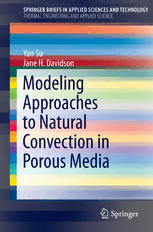
Modeling Approaches to Natural Convection in Porous Media PDF
Preview Modeling Approaches to Natural Convection in Porous Media
SpringerBriefs in Applied Sciences and Technology SeriesEditor FrancisA.Kulacki DepartmentofMechanicalEngineering UniversityofMinnesota Minneapolis Minnesota USA Forfurthervolumes: http://www.springer.com/series/8884 Yan Su • Jane H. Davidson Modeling Approaches to Natural Convection in Porous Media 2123 YanSu JaneH.Davidson UniversityofMacau UniversityofMinnesota Taipa Minneapolis,Minnesota Macau USA ISSN2191-530X ISSN2191-5318(electronic) SpringerBriefsinAppliedSciencesandTechnology ISBN978-3-319-14236-4 ISBN978-3-319-14237-1(eBook) DOI10.1007/978-3-319-14237-1 LibraryofCongressControlNumber:2015930993 SpringerChamHeidelbergNewYorkDordrechtLondon © TheAuthors2015 Thisworkissubjecttocopyright.AllrightsarereservedbythePublisher,whetherthewholeorpartofthe materialisconcerned,specificallytherightsoftranslation,reprinting,reuseofillustrations,recitation, broadcasting,reproductiononmicrofilmsorinanyotherphysicalway,andtransmissionorinformation storageandretrieval,electronicadaptation,computersoftware,orbysimilarordissimilarmethodology nowknownorhereafterdeveloped. Theuseofgeneraldescriptivenames,registerednames,trademarks,servicemarks,etc.inthispublication doesnotimply,evenintheabsenceofaspecificstatement,thatsuchnamesareexemptfromtherelevant protectivelawsandregulationsandthereforefreeforgeneraluse. Thepublisher,theauthorsandtheeditorsaresafetoassumethattheadviceandinformationinthisbook arebelievedtobetrueandaccurateatthedateofpublication.Neitherthepublishernortheauthorsorthe editorsgiveawarranty,expressorimplied,withrespecttothematerialcontainedhereinorforanyerrors oromissionsthatmayhavebeenmade. Printedonacid-freepaper SpringerispartofSpringerScience+BusinessMedia(www.springer.com) Preface Fluid flow and heat transfer in a porous medium are of interest in a number of engineering applications as well as in the environment. The primary purpose of thisbookmonographistointroducemodelingapproachesfornaturalconvectionin porous media. These models are applicable to a wide variety of media, including sand,soil,randomlypackedspheresorcylindricaltubes,andopencellmetalfoams, which have gained attention in recent years as potentially excellent candidates for meetingthehighthermaldissipationdemandsintheelectronicsindustry. Asanintroductiontothetopicofheatandmasstransferinporousmedia,Chap.1 introduces the conventional defining parameters used to specify porous media and providesanoverviewofthegoverningequationsandbackgroundmaterialthatset thestageforunderstandingmodelingefforts.Thelocalthermalequilibrium(LTE) andnonlocalthermalequilibrium(NLTE)approachesareintroducedandcompared. Chapter2extendsthetheoreticalpresentationtoconsiderationofthemicroscopic governingequationsandvolume-averagedmacroscopicequationsforflowandnat- uralconvectionheattransfer.Thetheoreticaldevelopmentconnectsthemicroscopic dragandheatfluxbetweensolidandfluidphasesinaporousmediumthroughare- centlydevelopedgeometryfactor.Closuremodelsarepresentedinaformapplicable toaporousmediumofarbitrarymicroscopicgeometry. Chapter3introducesnumericalmethodsforsimulationofnaturalconvectionin porousmedia,includingthetraditionalfinitedifferencebasedprojectionmethodand thenondimensionallatticeBoltzmannmethod.Themodelsarediscussedintermsof thedimensionlessgoverningparametersfornaturalconvection. Meshmethodsare presentedforthefinitedifferenceandlatticeBoltzmannnumericalapproaches. Chapter4illustratestheapplicationofthepresentednumericalmethodstosim- ulatethetransientvelocityandtemperaturefieldsandglobalheattransferforinan adiabaticthinenclosurewithanembeddedheatsink.Inthisproblem,theheatsinkis aheatexchangercomposedofmultipletubes.Theexampleproblemisaninteresting applicationofthetheoryofporousmediumtoapracticalengineeringproblemand illustrates the enormous power of treating a heat exchanger as a porous medium. Problemsolutionsarepresentedviaporousmediummodelsimulationsbythepro- jection method and the non-dimensional lattice Boltzmann method, and by direct v vi Preface numericalsimulationswithnon-dimensionallatticeBoltzmannmethod.Advantages anddisadvantagesofeachnumericalapproachincludingcomparisonofthephysical resultsandtheCPUtimearediscussed.Inaddition,theuseofthegeometryfactor torepresenttheporousmediumisillustrated. Contents 1 IntroductionofFluidFlowandHeatTransferinPorousMedia..... 1 1.1 SpecificationofPorousMedia.............................. 1 1.2 PorousMediaModels..................................... 3 1.2.1 ModelsforFluidFlow............................. 3 2 AUniformTheoreticalModelforFluidFlowandHeatTransfer inPorousMedia .............................................. 9 2.1 MicroscopicGoverningEquations .......................... 9 2.2 MacroscopicGoverningEquations .......................... 10 2.3 ClosureModelsforMacroscopicEquations................... 11 2.3.1 ClosureModelforDrag............................ 11 2.3.2 RelationtotheDarcy–BrinkmanModel .............. 12 2.3.3 ClosureModelsforHeatTransferinPorousMedia ..... 13 3 NumericalMethods ........................................... 17 3.1 DimensionlessGoverningParameters........................ 17 3.2 DimensionlessGoverningEquations ........................ 18 3.3 ReviewofNumericalMethods ............................. 19 3.4 ProjectionMethod........................................ 20 3.4.1 IntroductionofProjectionMethod ................... 20 3.4.2 ProjectionMethodwithStaggedMeshes.............. 20 3.5 LatticeBoltzmannMethod................................. 21 3.5.1 IntroductiontoLatticeBoltzmannMethod ............ 21 3.5.2 NondimensionalLatticeBoltzmannMethod........... 23 4 IllustrationofNumericalApproaches............................ 27 4.1 ProblemDefinition ....................................... 27 4.2 ApplicationoftheNumericalMethods....................... 28 4.2.1 PorousMediumApproachbyProjectionMethod....... 29 4.2.2 PorousMediumApproachbyNDLBM............... 34 4.2.3 DirectSimulationApproachbyNDLBM ............. 35 4.3 ComparisonofResults .................................... 36 vii viii Contents 4.3.1 TankAveragedTemperatureandEnergyDischarged .... 36 4.3.2 TransientAveragedNusseltNumbersofTubes......... 36 4.3.3 TransientIsothermsandStreamlines ................. 37 4.3.4 ComparisonofCPUTimes ......................... 38 4.3.5 Summary........................................ 41 References........................................................ 43 List of Abbreviations a thefirstErgunconstant A area,m2 b thesecondErgunconstant B volumetricdragforce,N/m3 c microscopicdragcoefficientconstant c microscopicheattransfercoefficientconstant h c specificheatatconstantpressure,J/kg-K p C microscopicdragcoefficient,Eq.(2.14) D C Forcheimercoefficient,Eq.(2.24) F d hydraulicdiameter,m H d microscopicscalelengthscale,m d porediameter,m p D diameteroftheenclosure,m D2Q9 two-dimensionalninediscretevelocitydirectionlatticemesh Da Darcynumber,K/L2 eˆ unitdirectionvector g gravitationalconstant,kg-m/s2 h heattransfercoefficient,W/m2-K H heightoftheenclosure,m H porositylayerheight,m p k thermalconductivity,W/m-K k(cid:2) thermaldispersionconductivity,W/m-K k effectivethermalconductivity,Eq.(2.31),W/m-K m K permeability,m2 (cid:2) thethicknessofmicroscopicstructureofmetalfoam,m L macroscopicscalelengthscale,m LBM latticeBoltzmannmethod LTE localthermalequilibrium M constant0<M <1forEq.(2.31) n solidfluidinter-surfacedirectionvectorinanREV,m N thegridnumberinthemacroscopiclengthscaledirection NDLBM non-dimensionallatticeBoltzmannmethod ix x ListofAbbreviations NLTE nonlocalthermalequilibrium Nu microscopicNusseltnumberbasedonmicroscopicscale,hd/k d f Nu transientNusseltnumberbasedonH,Eq.(4.14) H Nu timeaveragedNu ,Eq.(4.16) H H Nu Nusseltnumberbasedonporousmedium(k /k )Nu ,Eq.(4.15) m f m H Nu timeaveragedNu m m p volumeaveragedpressure,φpˆ ,N/m2 f PPI poredensity,pores/inch Pr Prandtlnumber,ν/α q heatfluxbetweenthesolidandfluidinterfaceinperunitofREV,W/m3 sf Ra microscopicRayleighnumber, gβΔTd3 d νfαf Ra macroscopicRayleighnumber, gβΔTH3 H νfαf Ra porousmediumRayleighnumber,Ra Dak /k m H f m Re microscopicReynoldsnumber,|vˆ |d/ν d f f t time,s T temperature,K v microscopicvelocity,m/s v Darcyvelocity,φvˆ ,m/s f V elementaryvolumeinREV,m3 Greeksymbols α thermaldiffusivity,m2/s α(cid:2) thermaldispersiondiffusivity,m2/s β volumetrictemperatureexpansioncoefficient,K−1 (cid:8) thermaldispersivity φ porosity ΔT temperaturescale,K η dimensionlessgeometryfactor,A d/V fs s μ dynamicviscosityofthefluid,N-s/m2 ν kinematicviscosity,m2/s ρ density,kg/m3 Subscripts f fluid h heattransfercoefficient m porousmedium s solid Superscripts timeaverage ∗ dimensionlessvariable (cid:2) macroscopicvariable ∞ farfield
